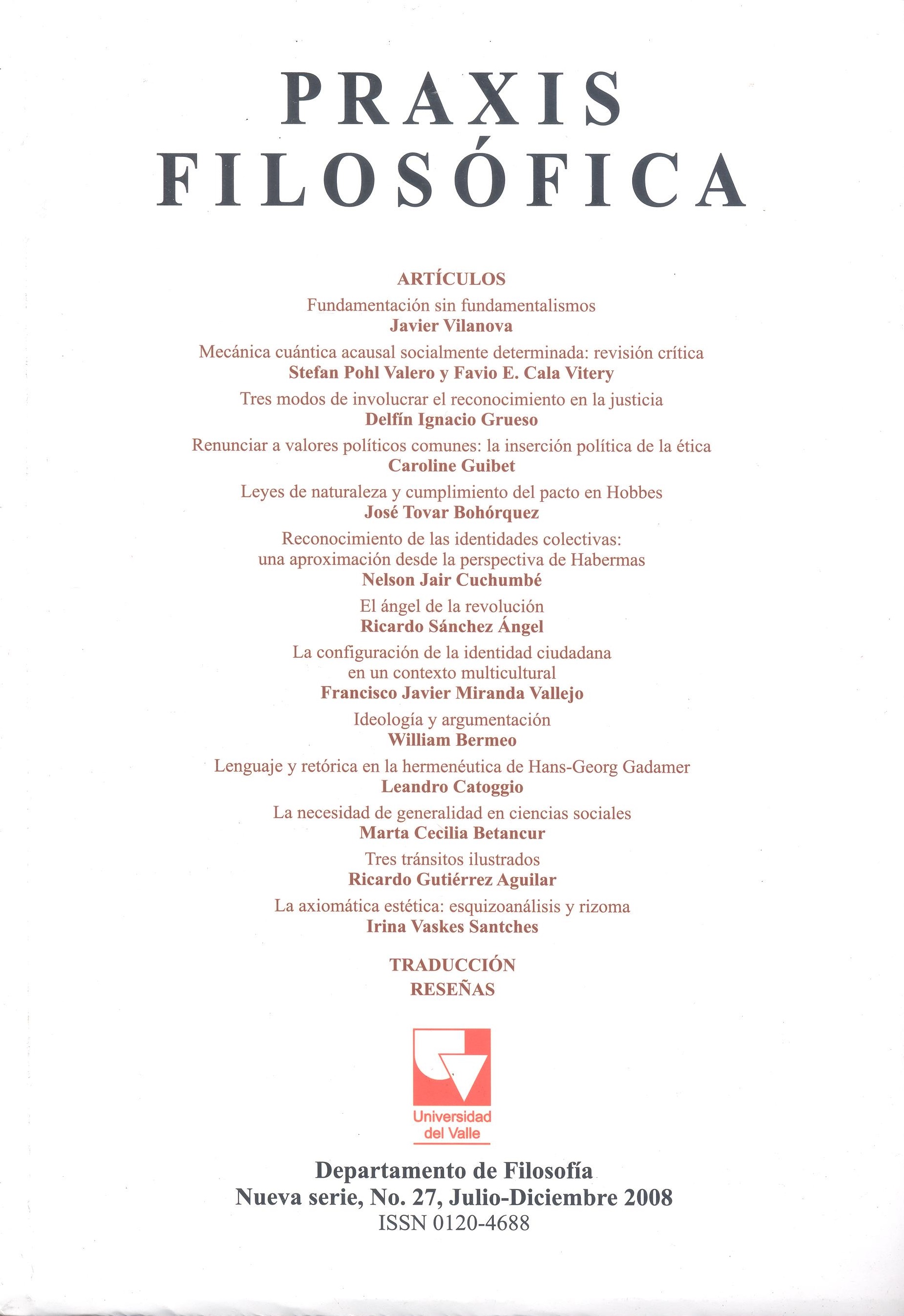Mecánica cuántica acausal socialmente determinada: revisión crítica
Palabras claves:
Forman ; historiograf ía. ; mecánica cuántica ; determinismo ; acausalidad ; historiografía ;Contenido principal del artículo
En su artículo titulado Weimar Culture; Causality and Quantum Theory,1918-1927: Adaptation by German Physicists to a Hostile IntellectualEnvironment, Paul Forman intentó dibujar una historia de la vieja mecánicacuántica según la cual la influencia cultural de la época resultó determinanteen la introducción, aceptación y asimilación de la acausalidad en esta teoría.Estas afirmaciones conocidas como las tesis de Forman, son puestas enperspectiva historiográfica, es decir, desde el panorama ofrecido por lastensiones propias de la historiografía y la filosofía de la ciencia contemporá-nea se perfila su importancia. Se argumenta que el dilema del determinismoes central en esta discusión y finalmente se presenta una breve revisióncrítica de las tesis de Forman revelando sus principales debilidades.
Bishop, R.C. (2002):ìDeterministic and Indeterministic Descriptionsî, en H.Atmans-pacher y R. Bishop (eds.),Between Chance and Choice, Londres, ImprintAcademic, pp. 5-31.
Bohm, D. (1952): ìA Suggested Interpretation of Quantum Mechanics in Terms ofëHiddeníVariables, I and IIî,Physical Review,85, pp. 166-179, 180-193.
Butterfeld, J. (1998): ìDeterminism and Indeterminismî en Edward Craig (ed.),Rout-ledge Encyclopedia of Philosophy, Vol.3, Londres-Nueva York, Routledge.Pp.33-39.
Earman, J (1986):APrimer on Determinism, Dordrecht, Reidel Publishing Company.
Forman, P. (1984):Cultura en Weimar, causalidad y teoría cuántica, 1918-1927.AdaptaciÛn de los fÌsicos y matemáticos alemanes a un ambiente intelectual hostil, Madrid,Alianza Editorial. Originalmente editado como artÌculo: Forman, P. [1971]: ìWeimar Culture; Causality and Quantum Theory, 1918-1927: Adaptation by German Physicists to a Hostile Intellectual Environ-mentî,Historical Studies in the Physical Sciences, 3, pp. 1-115.
Gideon, F. (2005): ìThe Hessen-Grossman Thesis: An Attempt at Rehabilitationî,Perspectives in Science, 13, pp.166-193.
Golinski, J. (1998):Making Natural Knowledge.Constructivism and the History ofScience, Cambridge, Cambridge University Press.
Hendry, J. (1980): ìWeimar Culture and Quantum Causalityî,History of Science, 18,pp. 155-180.
Hessen, B. (1931, 1971): ìThe Social and Economic Roots of Newtonís Principiaî, enN. Bukharin (ed.),Science at the crossroads, Londres, pp. 151-212.
Hoefer, C. (2004): ìCausality and Indeterminismî,Revista de FilosofÌa,29, pp. 99-115.
Kuhn, T.S. (1962):The structure of scientific revolutions, Chicago, University ofChicago Press.
Mendelsohn, E. (1989): ìRobert K. Merton: The Celebration and Defence of Scien-ceî,Science in Context, 3, 1, pp. 269-289.
Merton, R. (1938): ìScience, Technology and Society in Seventeenth Century En-glandî,Osiris, 4, pp. 360-632.
Prigogine, I. (1997):El fin de las certidumbres, Madrid, Taurus.
Radder, H. (1983): ìKramers and the Forman thesisî,History of Science, 21, pp. 165-182.
Rossi, P. (1990):Las arañas y las hormigas. Una apologÌa de la historia de la ciencia, Barcelona, CrÌtica.
SolÌs, C. (1994):Razones e intereses.La historia de la ciencia despuÈs de Kuhn,Barcelona, Paidos.
Sosa, E. y Tooley, M. (eds.) (1993):Causation, Oxford, Oxford University Press.

Esta obra está bajo una licencia internacional Creative Commons Atribución-NoComercial-CompartirIgual 4.0.
De acuerdo con nuestra política (Licencia Creative Commons CC BY-NC-SA 4.0) los artículos presentados y sometidos al proceso editorial en la revista Praxis Filosófica no tienen costo alguno para sus autores ni retribuciones económicas para la revista. El artículo de carácter inédito, producto de investigación o de algún proyecto que se presente a Praxis Filosófica, no podrá estar sometido a otro proceso de publicación durante el proceso que se lleve en nuestra revista.





